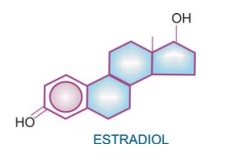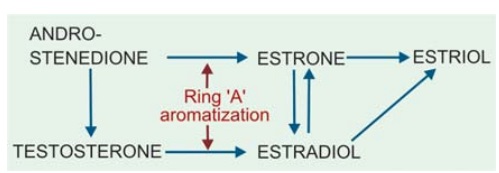Estrogens
| Home | | Pharmacology |Chapter: Essential pharmacology : Estrogens, Progestins and Contraceptives
These are substances which can induce estrus in spayed animals. It was established in the year 1900 that ovaries control female reproductive function through a hormonal mechanism.
ESTROGENS
(Female Sex Hormones)
These are substances
which can induce estrus in spayed animals.
It was established in
the year 1900 that ovaries control female reproductive function through a
hormonal mechanism. Allen and Doisy (1923) found that an alcoholic extract of
ovaries was capable of producing estrus and devised a simple bioassay method.
The active principle was obtained in pure form in 1929 and soon its chemical
structure was worked out.

Natural estrogens Estradiol is the major estrogen secreted by the ovary.
It is synthesized in the graafian follicle, corpus luteum and placenta from cholesterol.
Steps depicted on the right hand side in Fig. 20.1 are carried out. Further
steps are shown below.

Estradiol is rapidly
oxidized in liver to estrone which is
hydroxylated to form estriol. All
three are found in blood, but estradiol is the most potent estrogen. Small
quantity (2–20 μg/day) of estradiol is derived in human males also from
aromatization of testosterone in the testes and extraglandular tissues. In
mare, large quantity of equilin is
produced which has 1/5 estrogenic potency
of estradiol.
Synthetic estrogens Natural estrogens are inactive orally and have a short duration of
action due to rapid metabolism in liver. To overcome this, synthetic compounds
have been produced:
Steroidal Ethinylestradiol, Mestranol, Tibolone.
Nonsteroidal Diethylstilbestrol (stilbestrol), Hexestrol, Dienestrol
The nonsteroidal
compounds assume a trans configuration as depicted below and sterically
resemble natural estrogens.

Regulation Of Secretion
The daily secretion of estrogens in menstruating women varies from
10– 100 μg depending on the
phase of the cycle. Secretion starts from the graafian follicle under the
influence of FSH and the blood level rises gradually during the follicular phase.
Due to the modest preovulatory FSH surge, estrogens further rise transiently.
After ovulation, corpus luteum continues to secrete estrogens till about two
days before menstruation. Estrogens exercise feedback inhibition of FSH (also
LH at higher concentrations) by direct action on pituitary as well as through
hypothalamus.
During
pregnancy, placenta secretes large quantities of estrogens, reaching a peak of
upto 30 mg/day at term. Their level declines sharply after delivery. In the postmenopausal
women, daily production of estrogen has been estimated as 2–10 μg—derived primarily by
extraglandular aromatization of adrenal androgens.
Related Topics
